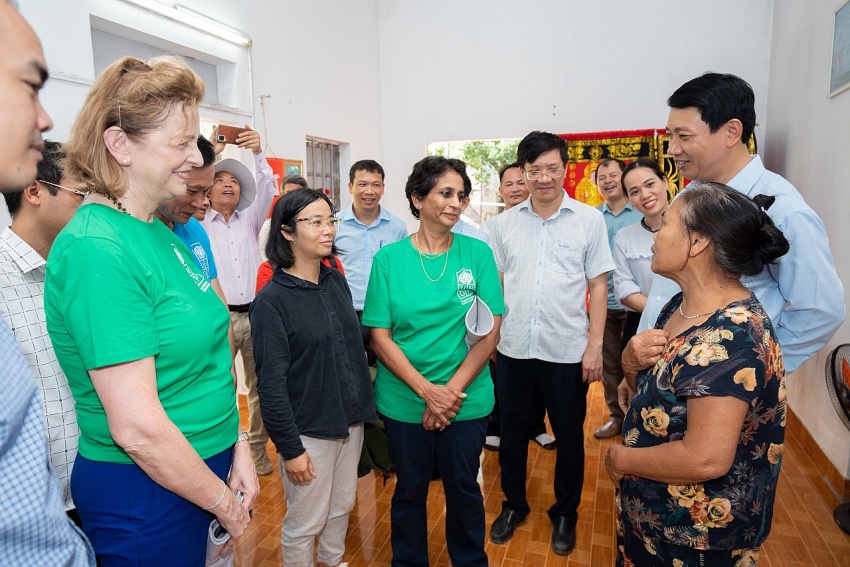UNDP regional director’s visit to Thanh Hoa province
Wignaraja commended the province for their unwavering commitment to adapting to the effects of a changing climate through various resilience-building initiatives.
 |
| UN assistant secretary-general and UNDP regional director for Asia and the Pacific Kanni Wignaraja met with local people in Thanh Hoa to advance cooperation to build community resilience |
Since 2017, the Vietnamese government, the Green Climate Fund (GCF), and the UNDP have regenerated and planted more than 337 hectares of mangroves and constructed 1,403 resilient houses for poor, near-poor, and women-headed households. This project, "Improving the resilience of vulnerable coastal communities to climate change-related impacts", has benefited more than 8,000 people in Thanh Hoa province.
Le Duc Giang, Vice Chairman of Thanh Hoa People’s Committee, expressed his gratitude for the support of the UNDP in enhancing the resilience and livelihoods of local communities.
Both the leaders emphasised the shared desire for further cooperation between the UNDP and the province to build more resilient houses; regenerate mangrove forests in ways that engage local communities with livelihoods; as well as increase local knowledge in disaster risk management.
"Mangroves are among the most effective nature-based solutions,” said UNDP resident representative in Vietnam Caitlin Wiesen, who joined the mangrove plantation. “They are a source of sustainable livelihoods such as aquaculture and beekeeping, while contributing to carbon sequestration, biodiversity conservation, protect lives, livelihoods, and infrastructure. They create a common benefit, both for reducing global climate change impacts and helping people to improve their livelihoods and income, as well as increasing the forest cover rate in Vietnam. They help Vietnam to achieve its climate and development ambitions in a resilient and sustainable way."
To identify safe locations for building resilient homes, the project has also conducted a series of community-based disaster risk management (CBDRM) activities, including risk assessments. To date, over 8,000 people (with over 50 percent women) have benefited from these trainings across the province, thus being able to assess the risks posed by disasters and climate change and develop location-specific disaster risk maps and risk reduction plans.
"According to a recent study by the UNDP and the Ministry of Construction, there is a need to provide resilient housing for an additional 110,000 households in 28 coastal provinces across the country, including over 10,000 in Thanh Hoa province,” Wignaraja noted in her meeting with the Thanh Hoa People’s Committee. “More than 8 per cent of the 25,000 resilient houses urgently needed in Vietnam are located in Thanh Hoa's coastal districts. The resilient houses supported by the GCF-funded coastal resilience project have withstood a series of record-level floods and storms in 2020. Given their efficacy together with the tremendous demand for more climate- and disaster-resilient housing, an additional 100 resilient houses will be constructed in Thanh Hoa province during the project extension period”.
Meanwhile, Global Environment Facility-funded projects implemented by the UNDP are promoting the sustainable use of the indigenous bamboo forest in Nguyet An commune of Ngoc Lac district, and revitalising traditional lac production for indigenous people in Muong Lat district. These projects serve as examples of a combination of selecting a tree species with high economic value and an open market, using indigenous knowledge with modern farming technologies, and focusing on breeding and intensive farming, with the participation and approval of the people.
What the stars mean:
★ Poor ★ ★ Promising ★★★ Good ★★★★ Very good ★★★★★ Exceptional
 Tag:
Tag:
Related Contents
Latest News
More News
- Protect what’s next: towards a future free from meningococcal group B disease (December 05, 2025 | 18:00)
- New ILO report offers policy recommendations for disability inclusion (December 04, 2025 | 15:18)
- Maternal job loss may affect children’s mental health, research shows (December 03, 2025 | 19:11)
- Women lead Vietnam’s shift to climate-resilient agriculture (December 03, 2025 | 19:10)
- Experts highlight unpaid care work as key barrier to gender equality (December 03, 2025 | 15:15)
- Opportunities and inequalities for women workers in Vietnam's garment industry (December 03, 2025 | 09:00)
- Vietjet flights carry love to devastated central region (November 28, 2025 | 11:35)
- New initiative to boost the fight against domestic violence (November 26, 2025 | 10:00)
- South Korea funds IOM relief for Vietnam’s typhoon-affected communities (November 24, 2025 | 15:33)
- AI and human-centred values set to shape the future of HR in Vietnam (November 21, 2025 | 18:04)




























 Mobile Version
Mobile Version